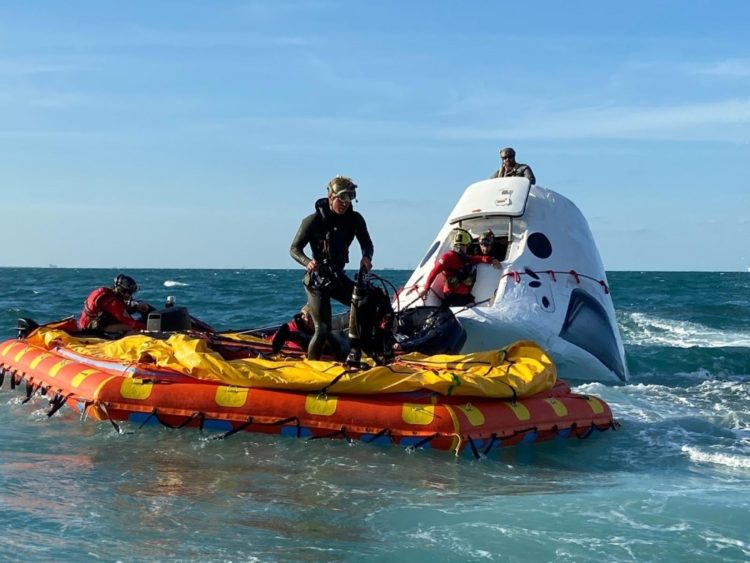SpaceX’s Falcon 9 spacecraft launched from the Kennedy Space Center on May 30th. This was the first spacecraft to take off from the Kennedy Space Center’s pad since the Space Shuttle Program was shut down in 2011.
The Defense Visual Information Distribution Service was on the front lines of this historic event. They provided an in-depth story and personal interviews with those present.
Hordes of people came to watch the historic liftoff, not to mention the thousands that watched it remotely. Among all these people, there was a small group watching with intense eyes, hoping for the best, but prepared for the worst. These people were the Air Force’s 58th Rescue Squadron’s Guardian Angels, out of Nellis Air Force Base.
These Guardian Angels are the Air Force’s elite Pararescuemen, better known as PJs. These personnel recovery experts were split up into three Space Flight Support Force teams — strategically located at Patrick Air Force Base, Florida, Joint Base Charleston, South Carolina, and Joint Base Pearl Harbor-Hickam, Hawaii — to support this very important space mission.
Being a part of this event was a historic tradition for the Pararescue community. As Major Lucas Gagliardi, a member of the 58th Rescue Squadron and director of operations, pointed out, “Pararescue has been a part of manned space flight since it began in the 1960s, so to be included in the first team to bring back some of our heritage was a super humbling and awesome experience.”
The three teams were tactfully located to respond if an emergency occurred and the mission was forced to abort at any time before the spacecraft linked up with the International Space Station.
The preparation for this special mission was intense. A month before the launch took place, the three teams, comprised of Combat Rescue Officers and PJs, went to Cocoa Beach, Florida to participate in Just-in-Time-Training (JITT) with Detachment 3, a unit attached to the 45th Space Wing, out of Patrick Air Force Base.
Gagliardi summed up the month of intense training: “We spent, between 12 to 14 hours daily, working in the basin and getting hands-on training with the capsule. We had a wide variety of instructors from retired Pararescuemen, to pilots, firefighters, doctors, basically the whole gamut of rescue personnel who each brought their unique, capabilities and expertise to train us up for this mission.”
He went on to say, “If something were to go wrong, we [were] trained to be able to support multiple contingencies and hazards during day or night ops. For example, in all these scenarios we had to be prepared to execute a recovery in the open ocean for up to 72 hours, treating patients until a helicopter arrived or a recovery by a ship of opportunity [sic].”
The team at Patrick Air Force Base was staged with HH-60 Pavehawk helicopters and an HC-130 Combat King II. That team was to respond to an incident happening before or shortly after liftoff.
Once the Falcon 9 proceeded on its route, the team at Joint Base Charleston took the watch, accompanied by a C-17 Globemaster III, which could take the Pararescue team anywhere up and down the East Coast to respond to an incident.
Already have an account? Sign In
Two ways to continue to read this article.
Subscribe
$1.99
every 4 weeks
- Unlimited access to all articles
- Support independent journalism
- Ad-free reading experience
Subscribe Now
Recurring Monthly. Cancel Anytime.
On the last leg of the trip, prior to the Falcon 9’s arrival to the International Space Station, the third team at Joint Base Pearl Harbor-Hickam took over. They had a C-17 at their disposal, which could take them anywhere they needed to go in the Pacific Ocean.
In total, the teams were on call for 24 hours. Thankfully, the space mission went according to plan and the Pararescue teams did not have to put their training to the test.
With this new advent of space travel, the Air Force Pararescuemen community and the 58th Rescue Squadron look forward to further employment, serving space missions into the future.
Major Gagliardi is excited about the opportunities that lie ahead for the 58th Rescue Squadron. “We are sending personnel back to Florida to train and support the recovery of the capsule from this launch, and we will be there to support future launches. This readiness embodies the unique capabilities Guardian Angel Squadrons bring to the Air Force and the country.”











COMMENTS
You must become a subscriber or login to view or post comments on this article.